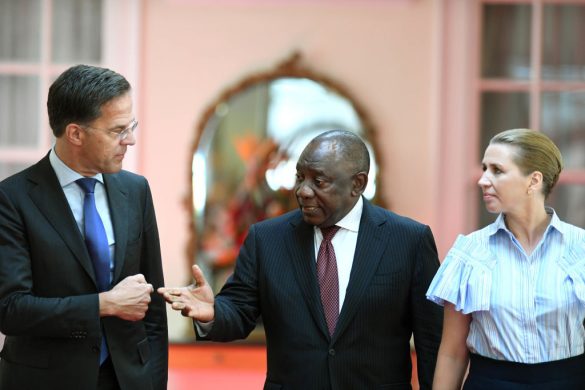Dagen før statsminister Helle Thorning-Schmidt (S) kom på besøg, fremlagde FNs Højkommissær for Menneskerettigheder flere eksempler på, hvordan selv mindreårige børn lemlæstes i Tanzania, mens de skrigende beder for deres liv.
GENEVA, 5 March 2013: The UN High Commissioner for Human Rights, Navi Pillay, said Tuesday she was appalled by (oprørt over) reports of an upsurge in attacks against people with albinism in Tanzania, and called on the authorities there to take stronger measures to halt the crimes and tackle the underlying discrimination.
“I strongly condemn these vicious killings and attacks, which were committed in particularly horrifying circumstances, and which have involved dismembering (lemlæste) people, including children, while they are still alive,” Pillay said.
Four new attacks targeting people with albinism, three of whom were children, were documented in Tanzania in a period of just 16 days:
* On 31 January, Lugolola Bunzari, a 7-year-old boy with albinism was brutally murdered in Kanunge village, Tabora region. His attackers slashed his forehead, right arm and left shoulder, and chopped off (afskar) his left arm just above the elbow. The boy’s grandfather, aged 95, was also killed in the attack as he tried to protect his grandson.
* On 5 February, a 7-month-old baby, Makunga Baraka, narrowly escaped death after armed men attacked his home in the Simiyu region. Villagers chased the attackers away and surrounded the house to protect him. The baby and his mother were taken to the police station the following morning and given temporary sanctuary.
* On 11 February, at around 2:00 a.m., Maria Chambanenge, a 39-year-old woman with albinism was attacked by five armed men, allegedly including her husband, in Mkowe village, Rukwa region. They hacked off her left arm while she was sleeping with two of her four children. The five suspects were subsequently arrested and the victim’s arm recovered. Their trial is reported to be under way.
* On 15 February, Mwigulu Matonange, a 10-year-old boy with albinism was attacked on his way home from school, and his left arm chopped off above the elbow by two unidentified men in Msia village, Rukwa region. Three men have been arrested in connection with the attack. Following the attack, the boy is reported to have asked his father to find him “a school where the bad men cannot find me and chop off my other arm.”
Sammenkædes med trolddomskraft
The killing and mutilation (lemlæstelse) of people with albinism is often linked to witchcraft (trolddomskraft).
Some practitioners allegedly believe that the witchcraft is more powerful if the victim screams during the amputation, which explains why the body parts are often cut from live victims.
In addition to the Maria Chambanenge case where trials are already underway, Tanzanian police have reportedly opened investigations in two of the other three cases that occurred since late January.
However, in general, successful prosecutions are extremely rare: out of the 72 murders of people with albinism documented in Tanzania since 2000, only five cases are known to have resulted in successful prosecutions.
“These crimes are abhorrent (afskyvækkende),” Navi Pillay said.
“People with albinism have the right to start living, like anyone else, without fear of being killed or dismembered. The Tanzanian authorities have the primary responsibility to protect people with albinism, and to fight against impunity, which is a key component for prevention and deterrence of the crimes targeting this exceptionally vulnerable community,” she said, adding:
“I urge the Tanzanian authorities to strengthen their legal response to such crimes and increase their efforts to bring perpetrators (gerningsmændene) of attacks and killings to justice.”
Noting that witchcraft beliefs and practices are entrenched (dybt rodfæstet) in some segments of Tanzanian society, Pillay called on the authorities to address the issue through a multi-pronged approach.
Læs videre på
http://www.ohchr.org/EN/NewsEvents/Pages/Media.aspx?IsMediaPage=true&LangID=E
Begynd fra: “As well as physically protecting people with albinism, the Government needs….”
Hvad er albinisme?
Albinisme har været kendt langt tilbage i historien og beskrives bl.a. i Dødehavsrullerne. Den første videnskabelige beskrivelse blev foretaget i 1908 af den engelske læge Sir Archibald Garrod.
Albinisme er en fælles betegnelse for en række arvelige, medfødte tilstande, der er kendetegnet ved nedsat eller manglende evne til at danne pigment.
Pigment er et farvestof, melanin, der beskytter mod solens stråler. Det kan mangle i både hud, hår og øjne, i nogle tilfælde kun i øjnene.
Albinisme medfører forskellige synsproblemer, øget følsomhed for sollys med en øget risiko for solskader i huden og i varierende grad et anderledes udseende.
Albinisme opdeles i 2 hovedtyper: okulo-kutan albinisme, der omfatter hud, hår og øjne, og okulær albinisme, der især omfatter øjnene.
Begge typer kan opdeles i flere undertyper, og med genteknologiens udvikling kommer der stadig nye til.
Se mere om albinisme på http://www.albinisme.dk/node/4














